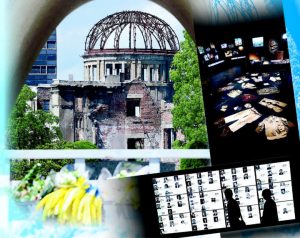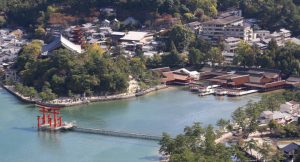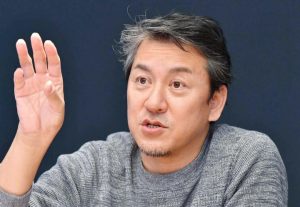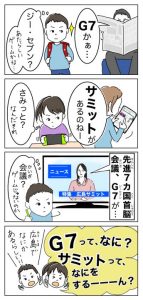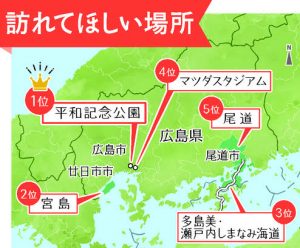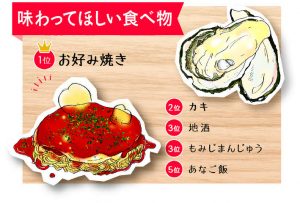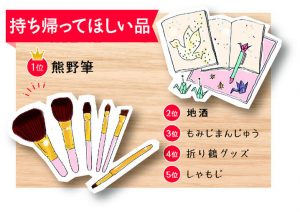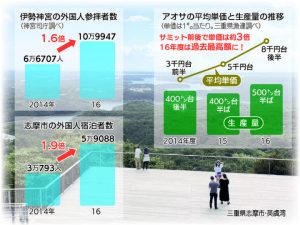What do readers want to communicate to the world about Hiroshima at this time, 200 days before the Hiroshima Summit 2023?
Oct. 31, 2022
There are 200 days until the opening of a political event grabbing the attention of the world—the summit meeting of the G7 (attended by the Group of Seven industrialized nations). The summit will be held May 19–21 next year for the first time in Hiroshima City. What of Hiroshima’s attractive qualities should be communicated at the occasion of the G7 Hiroshima Summit, when thousands of government officials and media, as well as political leaders, will crowd in to Hiroshima? In our survey of readers, keywords mentioned most often, as expected, were “Peace” and “Recovery.”
by Michiko Tanaka
Hiroshima Peace Memorial Park, located in the city’s Naka Ward, came in a decisive first place, with 80 percent of survey respondents selecting the park or the facilities inside the park, including the Cenotaph for the A-bomb Victims, the Hiroshima Peace Memorial Museum, the Atomic Bomb Dome, and the Hiroshima National Peace Memorial Hall for the Atomic Bomb Victims. Although not a place, some people expressed the opinion that they wanted people related to the summit to “meet with A-bomb survivors to listen to their stories.”
As many civilians have lost their lives and the risk of nuclear weapons being used by Russia has grown since that country invaded Ukraine eight months ago, respondents likely were thinking deeply about the significance of holding the summit in the A-bombed city. Shuji Mitani, 40, a company employee in Fukuyama City, chose the Peace Memorial Museum in the hopes that “people would learn about the inhumane nature of nuclear weapons now that Russia is threatening the use of such weapons.”
Among those participating in the summit, the only country whose acting leader has been to Hiroshima, excluding Japan’s prime minister, is the United States. Then-U.S. President Barak Obama visited Hiroshima in 2016 following the G7 Ise-Shima Summit in Mie Prefecture, offering flowers at the Cenotaph for the A-bomb Victims and visiting the peace museum. The Hiroshima Summit will provide the first opportunity to visit Hiroshima for the leaders of the other five nations, including two other nuclear powers Britain and France. A 51-year-old farmer in Kure City said, “I would like the leaders of the nuclear weapons states as well as those of countries reliant on that nuclear umbrella to feel the horrors of the weapon.” A 40-year-old part-time employee in Hiroshima’s Saeki Ward requested that the visitors “look at the museum’s exhibits one by one, not like the way Mr. Obama did in the short time he was in the city.”
In addition to the entire park area, A-bombed facilities, such as the former Army Clothing Depot, the largest set of A-bombed buildings in Hiroshima (located in the city’s Minami Ward), and a special nursing home for A-bomb survivors, were also mentioned by readers. Their thoughtful reasoning included the ideas, “We want the national leaders to make a firm resolution to keep peace” and “We do not want them to have the summit in Hiroshima unless they learn about the devastation caused by the atomic bombing.”
Miyajima (located in Hatsukaichi City), an island registered as a World Heritage Site, ranked second in places at which people wanted the visitors to spend time. Major restoration work on the island’s Itsukushima Shrine O-torii Gate, conducted for the first time in about 70 years, is nearly finished. Local pride in the area was evident in such comments as, “I would like people to observe the O-torii Gate, which is more beautiful than before” and “Miyajima rivals the Mont-Saint-Michel in France.”
Coming in third were “places where the beauty of the islands of the Seto Inland Sea can be viewed.” Some named the Shimanami Kaido expressway as one of those places with the idea that, “I want people to enjoy the superb views.” In fourth spot was the MAZDA Zoom-Zoom Stadium (located in Minami Ward), home to the Hiroshima Toyo Carp pro baseball club, supported by the opinion, “I want people to see how loyal Carp fans root for the team.” Those spots were followed by the hilly Onomichi City, which ranked fifth.
by Miho Kuwajima
The most popular food choice in the survey was okonomiyaki, made up of a pile of shredded cabbage, slices of pork, soba or udon noodles, and other ingredients placed on a mixture of flour and water spread out crepe-like on a “teppan” steel griddle. Loved by everyone, regardless of nationality or age, okonomiyaki is Hiroshima’s ‘soul food.’
Okonomiyaki began as a confectionery called “Issen Yoshoku” (in English, ‘one-penny Western food’), becoming popular by being served at street food stalls and so on after World War II. A 71-year-old homemaker in Higashihiroshima City said, “The dish was designed to fill stomachs at a time when food was scarce.” Takayuki Nomura, a local government employee in Hiroshima’s Asakita Ward, expressed his hope that, “The international community will recognize diversity as present in okonomiyaki with its variety of ingredients.”
Oysters, a shellfish of which Hiroshima boasts Japan’s largest production volume, ranked second in the survey. With its tender but firm texture and rich flavor, some respondents replied that, “Any oyster dish is good” and “I was impressed when I first ate oysters in Hiroshima after moving here from another prefecture.” However, one concern voiced was that oysters might not be in season at the time the summit is being held.
Two items, popular as souvenirs, came in tied for third place in the survey with the same score—locally brewed sake and Momiji-manju (a kind of waffle shaped like a maple leaf and filled with sweet azuki beans). Exports of locally brewed Japanese sake in fiscal 2021 totaled 508 kiloliters, a 28.3 percent increase over the total of the previous year. Boosted by the tailwinds of a sake boom, exports to the United States and Asia are on the rise. As for Momiji-manju, some of the respondents recommended the fried variety of the sweet snack.
The food coming in the fifth spot was anago-meshi, a dish consisting of broiled conger eel served on boiled rice, followed by Seto Inland Sea products, such as sardines, sea bream, and rockfish, each of which garnered support. Uni-horen (a dish combining sea urchin and spinach sautéed with butter), which has recently gained hold as a new side dish at okonomiyaki restaurants, was also mentioned in the survey responses.
by Yumie Kubo
Kumanofude, brushes made in Kumano Town in Hiroshima Prefecture, were chosen as the number one souvenir that respondents hoped tourists would take back home with them after the summit. In addition to brushes for writing and painting, the production of which started in Japan’s Edo period (1603–1867), brushes used for application of cosmetics have been widely used since the 1950s. According to the Kumanofude cooperative (consisting of 86 businesses), many cosmetic brushes made in Kumano are exported to European countries and the United States, including the G7 nations.
When the Kumanofude cooperative held a virtual brush festival on the internet last year, people from 17 overseas countries participated. Shin Takemori, chief director of the cooperative who also serves as president of the brush manufacturer Chikuhodo Co., said, “We’ve been putting effort into making sure the Kumanofude brushes are recognized by big-name manufacturers and artists as being of high quality and easy to use.” The cooperative plans to redesign its website to better convey the charms of Kumanofude brushes.
Locally brewed sake ranked second in the survey. In addition to sake, some respondents recommended gin or wine made from local ingredients grown in Hiroshima. Third place went to Momiji-manju, buttressed by the opinion that, “I am curious to know what fillings are popular with people from what countries.”
In fourth place were paper crane-related products, based on the following reasons — “It is one manifestation of the desire for peace” and “I hope paper cranes can help strengthen the desire to abolish nuclear weapons.” The Hiroshima Summit Prefectural Civic Conference, a group composed of both public- and private-sector organizations, is seeking businesses and organizations that can develop and market products related to the summit. With that, it is likely that a variety of new paper-crane goods will make an appearance. In fifth place were rice ladles, a specialty from Miyajima.
On the other hand, some respondents were of the opinion that products and goods are not the only things visitors should take back home. With the hope that visitors take home the desire for nuclear abolition that will lead to action, some responded that, “I want visitors to learn thoroughly about the devastation resulting from the use of the atomic bomb and to communicate that information to the people in their own country” and “I want visitors to take home with them what they learned in Hiroshima.”
Survey methodology
Chugoku Shimbun’s editing department conducted the survey during the period October 1–10 using LINE, a freeware communication app, and the company’s U35 Instagram account, querying about expectations for the Hiroshima Summit regarding (1) Places to visit, (2) Foods to taste, and (3) Souvenirs to take home. About 200 readers responded.
by Naoki Enomoto
When the G7 Ise-Shima Summit was held in Shima City, Mie Prefecture in May 2016, the numbers of overseas tourists to the area and sales of local specialties rose significantly.
The effects of the summit began to become manifest in June 2015, the time the host city was determined. In 2016, the number of overseas visitors who stayed overnight in Shima City reached 59,088, about 1.9 times more than in 2014. The number of overseas visitors to the Ise Shrine in Ise City, where G7 nation leaders visited, rose to 109,947, an increase of about 1.6 times.
In terms of specialty products, food included in the meals offered during the meeting drew attention. One such item was sea lettuce. According to the Mie Prefecture fisheries cooperative association, the average unit price per kilogram was in the upper 8,000 yen range in fiscal 2016, nearly three times higher than the price in 2014, reaching an all-time high.
Shima City presented to the G7 leaders framed shell artwork and a pair of chopsticks decorated with real pearls, products made by Kazuhisa Sakai, 66, a craftsperson who operates a crafts company in the city, with the aim of promoting the area that was the first in the world to succeed at pearl cultivation. According to Mr. Sakai, sales of the pearl-imbued chopsticks increased about 50 percent after the summit, and he says he continues to receive orders for gift items from major corporations.
Mr. Sakai is the only local craftsman with the ability to shave fine layers of pearl oysters for processing into craft products. “People from other countries respect the delicate technical skills of Japanese artisans. We need to place emphasis on grooming successors to pave the way for the future,” said Mr. Sakai.
According to a survey carried out by the Shima City Society of Commerce and Industry of its 465 members in September 2016, following conclusion of the summit, 47.5 percent responded that the summit “had no economic impact on their business,” with only 19.4 percent replying “it had an economic impact.” Many of the opinions from the survey expressed that only certain lines of businesses enjoyed any benefit. Hiroshima is likely to face a similar challenge of how to equitably spread the positive effects from the summit to local industries.
Shotaro Yamabe, 52, chief producer of the Hiroshima Tourism Association, recently stressed that, “the Hiroshima Summit is a good opportunity for each of us, as people directly concerned, to communicate the numerous attractive qualities of Hiroshima, the international city of peace and culture. I hope to promote Hiroshima with a future orientation.”
What do you think of hosting the summit from a tourism perspective?
It’s the chance of a lifetime. “Hiroshima” is well-known to the world as the A-bombed city but not so much as a site for tourism. Some doubts exist about whether Hiroshima would be chosen by visitors from overseas as a tourist destination after Tokyo and Kyoto. However, this summit directly evokes Hiroshima. The key is how people of the hosting city choose to promote the various attractive qualities of Hiroshima with enthusiasm, from places for visiting to food for tasting.
How can that be done?
Local governments, businesses, and individuals have to think about their own ways of promoting the things they want to recommend to the people involved, but large-scale marketing efforts are not necessarily required. For example, visitors will be full after eating just one okonomiyaki dish, even if they want to try various local cuisines while here. How about providing a combination meal with a small okonomiyaki with other local dishes, such as koune (brisket) or gansu (boiled fish paste)? Let’s use the summit as an opportunity to increase the aspects for which Hiroshima is praised by other people. By doing so, Hiroshima’s self-esteem and happiness will grow. Tourism has benefits for everyone.
Even with the approach of the Hiroshima Summit, the situation in Ukraine is becoming more serious and its future prospects are increasingly uncertain.
Hiroshima has a major role to play in that situation. I have been feeling anew the significance of the city after returning to what is my home town for the first time in about 30 years. The world wants to hear a future-oriented message from Hiroshima, a city that serves as a symbol of resilience that has successfully recovered after the atomic bombing, reborn as a city of greenery. I hope the impact of holding the summit here will also lead to the further evolution of Hiroshima as an international city of peace and culture. (Interviewed by Yoko Yamamoto)
Profile
Shotaro Yamabe
Graduated in engineering from Kyoto University. After working for Recruit Co., and engaging in consulting at other corporations, Mr. Yamabe joined the company Calbee, Inc., in 2016, where he led the development of such new products as “Furu-shaka,” a fried potato snack. He assumed his current position as chief producer of the Hiroshima Tourism Association in April 2020. He began to develop an advertising campaign, called “Bakatare!!” (in English, ‘You idiot!’), in the greater Tokyo area that attracted public attention, with the aim of gaining support of people from Hiroshima Prefecture during the coronavirus pandemic. He is originally from Hiroshima’s Asaminami Ward.
The website page labeled “Topic Touch” posts educational information for children. The page has started posting a column to explain the G7 summit in clear and concise language. We invite everyone to access the site.
Graphics: Hayato Otomo and Tomoko Suenaga
Layout: Kazuma Sugihara
(Originally published on October 31, 2022)
Visitors should take the trip to Miyajima, but…
Hiroshima Peace Memorial Park came in decisive first: “We want people to feel the horrors of nuclear weapons”
by Michiko Tanaka
Hiroshima Peace Memorial Park, located in the city’s Naka Ward, came in a decisive first place, with 80 percent of survey respondents selecting the park or the facilities inside the park, including the Cenotaph for the A-bomb Victims, the Hiroshima Peace Memorial Museum, the Atomic Bomb Dome, and the Hiroshima National Peace Memorial Hall for the Atomic Bomb Victims. Although not a place, some people expressed the opinion that they wanted people related to the summit to “meet with A-bomb survivors to listen to their stories.”
As many civilians have lost their lives and the risk of nuclear weapons being used by Russia has grown since that country invaded Ukraine eight months ago, respondents likely were thinking deeply about the significance of holding the summit in the A-bombed city. Shuji Mitani, 40, a company employee in Fukuyama City, chose the Peace Memorial Museum in the hopes that “people would learn about the inhumane nature of nuclear weapons now that Russia is threatening the use of such weapons.”
Among those participating in the summit, the only country whose acting leader has been to Hiroshima, excluding Japan’s prime minister, is the United States. Then-U.S. President Barak Obama visited Hiroshima in 2016 following the G7 Ise-Shima Summit in Mie Prefecture, offering flowers at the Cenotaph for the A-bomb Victims and visiting the peace museum. The Hiroshima Summit will provide the first opportunity to visit Hiroshima for the leaders of the other five nations, including two other nuclear powers Britain and France. A 51-year-old farmer in Kure City said, “I would like the leaders of the nuclear weapons states as well as those of countries reliant on that nuclear umbrella to feel the horrors of the weapon.” A 40-year-old part-time employee in Hiroshima’s Saeki Ward requested that the visitors “look at the museum’s exhibits one by one, not like the way Mr. Obama did in the short time he was in the city.”
In addition to the entire park area, A-bombed facilities, such as the former Army Clothing Depot, the largest set of A-bombed buildings in Hiroshima (located in the city’s Minami Ward), and a special nursing home for A-bomb survivors, were also mentioned by readers. Their thoughtful reasoning included the ideas, “We want the national leaders to make a firm resolution to keep peace” and “We do not want them to have the summit in Hiroshima unless they learn about the devastation caused by the atomic bombing.”
Miyajima (located in Hatsukaichi City), an island registered as a World Heritage Site, ranked second in places at which people wanted the visitors to spend time. Major restoration work on the island’s Itsukushima Shrine O-torii Gate, conducted for the first time in about 70 years, is nearly finished. Local pride in the area was evident in such comments as, “I would like people to observe the O-torii Gate, which is more beautiful than before” and “Miyajima rivals the Mont-Saint-Michel in France.”
Coming in third were “places where the beauty of the islands of the Seto Inland Sea can be viewed.” Some named the Shimanami Kaido expressway as one of those places with the idea that, “I want people to enjoy the superb views.” In fourth spot was the MAZDA Zoom-Zoom Stadium (located in Minami Ward), home to the Hiroshima Toyo Carp pro baseball club, supported by the opinion, “I want people to see how loyal Carp fans root for the team.” Those spots were followed by the hilly Onomichi City, which ranked fifth.
Food that visitors should try: Okonomiyaki cooked on “teppan” (steel griddle)
by Miho Kuwajima
The most popular food choice in the survey was okonomiyaki, made up of a pile of shredded cabbage, slices of pork, soba or udon noodles, and other ingredients placed on a mixture of flour and water spread out crepe-like on a “teppan” steel griddle. Loved by everyone, regardless of nationality or age, okonomiyaki is Hiroshima’s ‘soul food.’
Okonomiyaki began as a confectionery called “Issen Yoshoku” (in English, ‘one-penny Western food’), becoming popular by being served at street food stalls and so on after World War II. A 71-year-old homemaker in Higashihiroshima City said, “The dish was designed to fill stomachs at a time when food was scarce.” Takayuki Nomura, a local government employee in Hiroshima’s Asakita Ward, expressed his hope that, “The international community will recognize diversity as present in okonomiyaki with its variety of ingredients.”
Oysters, a shellfish of which Hiroshima boasts Japan’s largest production volume, ranked second in the survey. With its tender but firm texture and rich flavor, some respondents replied that, “Any oyster dish is good” and “I was impressed when I first ate oysters in Hiroshima after moving here from another prefecture.” However, one concern voiced was that oysters might not be in season at the time the summit is being held.
Two items, popular as souvenirs, came in tied for third place in the survey with the same score—locally brewed sake and Momiji-manju (a kind of waffle shaped like a maple leaf and filled with sweet azuki beans). Exports of locally brewed Japanese sake in fiscal 2021 totaled 508 kiloliters, a 28.3 percent increase over the total of the previous year. Boosted by the tailwinds of a sake boom, exports to the United States and Asia are on the rise. As for Momiji-manju, some of the respondents recommended the fried variety of the sweet snack.
The food coming in the fifth spot was anago-meshi, a dish consisting of broiled conger eel served on boiled rice, followed by Seto Inland Sea products, such as sardines, sea bream, and rockfish, each of which garnered support. Uni-horen (a dish combining sea urchin and spinach sautéed with butter), which has recently gained hold as a new side dish at okonomiyaki restaurants, was also mentioned in the survey responses.
Souvenirs that visitors, including those from the West, should take back home: Kumanofude brushes
by Yumie Kubo
Kumanofude, brushes made in Kumano Town in Hiroshima Prefecture, were chosen as the number one souvenir that respondents hoped tourists would take back home with them after the summit. In addition to brushes for writing and painting, the production of which started in Japan’s Edo period (1603–1867), brushes used for application of cosmetics have been widely used since the 1950s. According to the Kumanofude cooperative (consisting of 86 businesses), many cosmetic brushes made in Kumano are exported to European countries and the United States, including the G7 nations.
When the Kumanofude cooperative held a virtual brush festival on the internet last year, people from 17 overseas countries participated. Shin Takemori, chief director of the cooperative who also serves as president of the brush manufacturer Chikuhodo Co., said, “We’ve been putting effort into making sure the Kumanofude brushes are recognized by big-name manufacturers and artists as being of high quality and easy to use.” The cooperative plans to redesign its website to better convey the charms of Kumanofude brushes.
Locally brewed sake ranked second in the survey. In addition to sake, some respondents recommended gin or wine made from local ingredients grown in Hiroshima. Third place went to Momiji-manju, buttressed by the opinion that, “I am curious to know what fillings are popular with people from what countries.”
In fourth place were paper crane-related products, based on the following reasons — “It is one manifestation of the desire for peace” and “I hope paper cranes can help strengthen the desire to abolish nuclear weapons.” The Hiroshima Summit Prefectural Civic Conference, a group composed of both public- and private-sector organizations, is seeking businesses and organizations that can develop and market products related to the summit. With that, it is likely that a variety of new paper-crane goods will make an appearance. In fifth place were rice ladles, a specialty from Miyajima.
On the other hand, some respondents were of the opinion that products and goods are not the only things visitors should take back home. With the hope that visitors take home the desire for nuclear abolition that will lead to action, some responded that, “I want visitors to learn thoroughly about the devastation resulting from the use of the atomic bomb and to communicate that information to the people in their own country” and “I want visitors to take home with them what they learned in Hiroshima.”
Survey methodology
Chugoku Shimbun’s editing department conducted the survey during the period October 1–10 using LINE, a freeware communication app, and the company’s U35 Instagram account, querying about expectations for the Hiroshima Summit regarding (1) Places to visit, (2) Foods to taste, and (3) Souvenirs to take home. About 200 readers responded.
Economic impact of Ise-Shima Summit
Numbers of overseas guests and sales of sea lettuce increased rapidly
by Naoki Enomoto
When the G7 Ise-Shima Summit was held in Shima City, Mie Prefecture in May 2016, the numbers of overseas tourists to the area and sales of local specialties rose significantly.
The effects of the summit began to become manifest in June 2015, the time the host city was determined. In 2016, the number of overseas visitors who stayed overnight in Shima City reached 59,088, about 1.9 times more than in 2014. The number of overseas visitors to the Ise Shrine in Ise City, where G7 nation leaders visited, rose to 109,947, an increase of about 1.6 times.
In terms of specialty products, food included in the meals offered during the meeting drew attention. One such item was sea lettuce. According to the Mie Prefecture fisheries cooperative association, the average unit price per kilogram was in the upper 8,000 yen range in fiscal 2016, nearly three times higher than the price in 2014, reaching an all-time high.
Shima City presented to the G7 leaders framed shell artwork and a pair of chopsticks decorated with real pearls, products made by Kazuhisa Sakai, 66, a craftsperson who operates a crafts company in the city, with the aim of promoting the area that was the first in the world to succeed at pearl cultivation. According to Mr. Sakai, sales of the pearl-imbued chopsticks increased about 50 percent after the summit, and he says he continues to receive orders for gift items from major corporations.
Mr. Sakai is the only local craftsman with the ability to shave fine layers of pearl oysters for processing into craft products. “People from other countries respect the delicate technical skills of Japanese artisans. We need to place emphasis on grooming successors to pave the way for the future,” said Mr. Sakai.
According to a survey carried out by the Shima City Society of Commerce and Industry of its 465 members in September 2016, following conclusion of the summit, 47.5 percent responded that the summit “had no economic impact on their business,” with only 19.4 percent replying “it had an economic impact.” Many of the opinions from the survey expressed that only certain lines of businesses enjoyed any benefit. Hiroshima is likely to face a similar challenge of how to equitably spread the positive effects from the summit to local industries.
Interview with Shotaro Yamabe, chief producer of Hiroshima Tourism Association: Market Hiroshima with passion
Shotaro Yamabe, 52, chief producer of the Hiroshima Tourism Association, recently stressed that, “the Hiroshima Summit is a good opportunity for each of us, as people directly concerned, to communicate the numerous attractive qualities of Hiroshima, the international city of peace and culture. I hope to promote Hiroshima with a future orientation.”
What do you think of hosting the summit from a tourism perspective?
It’s the chance of a lifetime. “Hiroshima” is well-known to the world as the A-bombed city but not so much as a site for tourism. Some doubts exist about whether Hiroshima would be chosen by visitors from overseas as a tourist destination after Tokyo and Kyoto. However, this summit directly evokes Hiroshima. The key is how people of the hosting city choose to promote the various attractive qualities of Hiroshima with enthusiasm, from places for visiting to food for tasting.
How can that be done?
Local governments, businesses, and individuals have to think about their own ways of promoting the things they want to recommend to the people involved, but large-scale marketing efforts are not necessarily required. For example, visitors will be full after eating just one okonomiyaki dish, even if they want to try various local cuisines while here. How about providing a combination meal with a small okonomiyaki with other local dishes, such as koune (brisket) or gansu (boiled fish paste)? Let’s use the summit as an opportunity to increase the aspects for which Hiroshima is praised by other people. By doing so, Hiroshima’s self-esteem and happiness will grow. Tourism has benefits for everyone.
Even with the approach of the Hiroshima Summit, the situation in Ukraine is becoming more serious and its future prospects are increasingly uncertain.
Hiroshima has a major role to play in that situation. I have been feeling anew the significance of the city after returning to what is my home town for the first time in about 30 years. The world wants to hear a future-oriented message from Hiroshima, a city that serves as a symbol of resilience that has successfully recovered after the atomic bombing, reborn as a city of greenery. I hope the impact of holding the summit here will also lead to the further evolution of Hiroshima as an international city of peace and culture. (Interviewed by Yoko Yamamoto)
Profile
Shotaro Yamabe
Graduated in engineering from Kyoto University. After working for Recruit Co., and engaging in consulting at other corporations, Mr. Yamabe joined the company Calbee, Inc., in 2016, where he led the development of such new products as “Furu-shaka,” a fried potato snack. He assumed his current position as chief producer of the Hiroshima Tourism Association in April 2020. He began to develop an advertising campaign, called “Bakatare!!” (in English, ‘You idiot!’), in the greater Tokyo area that attracted public attention, with the aim of gaining support of people from Hiroshima Prefecture during the coronavirus pandemic. He is originally from Hiroshima’s Asaminami Ward.
The website page labeled “Topic Touch” posts educational information for children. The page has started posting a column to explain the G7 summit in clear and concise language. We invite everyone to access the site.
Graphics: Hayato Otomo and Tomoko Suenaga
Layout: Kazuma Sugihara
(Originally published on October 31, 2022)

